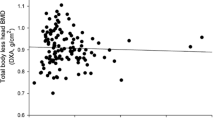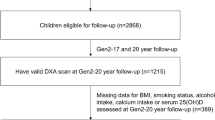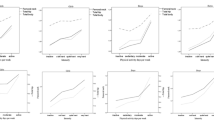Abstract
Summary
Physical activity (PA) have long been identified as a determining factor of the mineralization of the skeleton, particularly in children. Our research supports the hypothesis that the geometry of the pelvis and proximal femur (PF) might moderate the effect of PA in the relative mineralization of the PF subregions.
Introduction
Using a longitudinal observational study with two evaluations and a 1-year follow-up interval, we investigated the influence of PA and skeletal geometry in bone mineral density (BMD) and bone mass distribution at the PF in 96 girls and 81 boys (10–12 years). It is plausible that the geometry of the pelvis-PF structure moderates mechanical forces exerted at the hip and therefore creates different degrees of mineralization among PF subregions.
Methods
Whole body and left hip dual X-ray absorptiometry scans were used to derive geometric measures of the pelvis—inter-acetabular distance (IAD) and PF abductor lever arm (ALA). BMD was measured at the integral, superolateral (SL), and inferomedial (IM) femoral neck (FN), and at the trochanter (TR). These subregions were used to represent bone mass distribution via three BMD ratios: FN/PF, IM/SL, and TR/PF. PA was measured using accelerometry and a bone-specific PA questionnaire (BPAQ).
Results
A longitudinal data approach revealed BPAQ as a positive predictor for all BMD variables (p < 0.05) except TR BMD in girls and FN BMD in boys. Comparing the most active with the less-active participants, the greatest benefits of PA were observed at the FN of the girls with the lowest IAD (p < 0.001), at the FN of the boys with the highest IAD (p < 0.001) and at the TR of the boys with the lowest ALA (p < 0.01).
Conclusions
Geometric measures of IAD and ALA seem to moderate the effect of PA role in the relative mineralization of the PF regions. On the other hand, absolute BMD levels appear to be determined by mechanical loading.



Similar content being viewed by others
References
Bonjour JP, Theintz G, Buchs B, Slosman D, Rizzoli R (1991) Critical years and stages of puberty for spinal and femoral bone mass accumulation during adolescence. J Clin Endocrinol Metab 73(3):555–563
Karagas MR, Lu-Yao GL, Barrett JA, Beach ML, Baron JA (1996) Heterogeneity of hip fracture: Age, race, sex, and geographic patterns of femoral neck and trochanteric fractures among the US elderly. Am J Epidemiol 143(7):677–682
Löfman O, Berglund K, Larsson L, Toss G (2002) Changes in hip fracture epidemiology: redistribution between ages, genders and fracture types. Osteoporos Int 13(1):18–25
Jamlo GB, Jakobsson B, Ceder L, Thorngren KG (1989) Hip fracture incidence in Lund, Sweden, 1966–1986. Acta Orthop Scand 60(3):278–282
Baudoin C, Fardellone P, Sebert JL (1993) Effect of sex and age on the ratio of cervical to trochanteric hip fracture. A meta analysis of 15 reports on 36,451 cases. Acta Orthop Scand 64(6):647–653
Gnudi S, Ripamontil C, Lisi L, Fini M, Giardino R, Giavaresi G (2002) Proximal Femur Geometry To Detect and Distinguish Femoral Neck Fractures from Trochanteric Fractures in Postmenopausal Women. Osteoporos Int 13(1):69–73
Duboeuf F, Hans D, Schott AM, Kotzki PO, Favier F, Marcelli C, Meunier PJ, Delmas PD (1997) Different morphometric and densitometric parameters predict cervical and trochanteric hip fracture: the EPIDOS Study. J Bone Miner Res 12(11):1895–1902
Faulkner KG (1996) Hip axis length and osteoporotic fractures. J Bone Miner Res 10:506–508
Partanen J, Jämsä T, Jalovaara P (2001) Influence of the upper femur and pelvic geometry on the risk and type of hip fractures. J Bone Miner Res 16(8):1540–1546
Glüer CC, Cummings SR, Pressman A, Li J, Glüer K, Faulkner K, Grampp S, Genant HK (1994) Prediction of hip fractures from pelvic radiographs: the study of osteoporotic fractures. J Bone Miner Res 9(5):671–677
Mautalen CA, Vega EM, Einhorn TA (1996) Are the etiologies of cervical and trochanteric hip fractures different? Bone 18(3):S133–S137
Carpenter RD, Beaupré GS, Lang TF, Orwoll ES, Carter DR (2005) New QCT analysis approach shows the importance of fall orientation on femoral neck strength. J Bone Miner Res 20(9):1533–1542
McGrory BJ, Morrey BF, Cahalan TD, An KN, Cabanela ME (1995) Effect of femoral offset on range of motion and abductor muscle strength after total hip arthroplasty. J Bone Joint Surg (Br) 77(6):865–869
Maquet P (1990) Importance of the position of the greater trochanter. Acta Orthop Belg 56:307–322
Preininger B, Schmorl K, Von Roth F, Winkler T, Schlattmann P, Matziolis G, Perka C, Tohtz S (2011) A formula to predict patients’ gluteus medius muscle volume from hip joint geometry. Manual 16(5):447–451
Brinckmann P, Hoefert H, Jongen HT (1981) Sex differences in the skeletal geometry of the human pelvis and hip joint. J Biomech 14:427–430
Beck TJ, Ruff CB, Shaffer RA, Betsinger K, Trone DW, Brodine SK (2000) Stress fracture in military recruits: gender differences in muscle and bone susceptibility factors. Bone 27(3):437–444
Seike K, Koda K, Oda K, Kosugi C, Shimizu K, Miyazaki M (2009) Gender differences in pelvic anatomy and effects on rectal cancer surgery. Hepatogastroenterology 56(89):111–115
Kettles M, Cole CL, Wright BS (2006) Sex differences in anatomy, physiology, psychosociology and mortality. In: Kettles M, Cole CL, Wright BS (eds) Women’s health and fitness guide. Human Kinetics, Champaign, pp 4–14
Chumanov ES, Wall-Scheffler C, Heiderscheit BC (2008) Gender differences in walking and running on level and inclined surfaces. Clin Biomech 23(10):1260–1268
Hurd WJ, Chmielewski TL, Axe MJ, Davis IM, Snyder-Mackler L (2004) Differences in normal and perturbed walking kinematics between male and female athletes. Clin Biomech 19(5):465–472
Ferber R, Davis IM, Williams DS (2003) Gender differences in lower extremity mechanics during running. Clin Biomech 18(4):350–357
Eisman JA, Kelly PJ, Morrison NA, Pocock NA, Yeomon R, Birminghan J, Sambrook PN (1993) Peak bone mass and osteoporosis prevention. Osteoporosis Int 3(1):S56–S60
Baxter-Jones AD, Faulkner RA, Forwood M, Mirwald RL, Bailey DA (2011) Bone mineral accrual from 8 to 30 years of age: an estimation of peak bone mass. J Bone Miner Res 26(8):1729–1739
Meyer U, Romann M, Zahner L, Schindler C, Puder J, Kraenzlin M, Rizzoli R, Kriemler S (2011) Effect of a general school-based physical activity intervention on bone mineral content and density: a cluster-randomized controlled trial. Bone 48(4):792–797
Jones G, Dwyer T (1998) Bone mass in prepubertal children: gender differences and the role of physical activity and sunlight exposure. J Clin Endocrinol Metab 83(12):4274–4279
Kriemler S, Zahner L, Puder J, Braun-Fahrländer C, Schindler C, Farpour-Lambert N, Kränzlin M, Rizzoli R (2008) Weight-bearing bones are more sensitive to physical exercise in boys than in girls during pre- and early puberty: a cross-sectional study. Osteoporos Int 19(12):1749–1758
Cardadeiro G, Baptista F, Zymbal V, Rodrigues L, Sardinha L (2010) Ward’s area location, physical activity and body composition in 8 and 9 years old boys and girls. J Bone Miner Res 25(11):1–10
Cardadeiro G, Baptista F, Ornelas R, Janz K, Sardinha L (2012) Sex specific association of physical activity on proximal femur BMD in 9 to 10 years-old children. PLoS ONE 7(11):e50657
Lin WP, Wen CJ, Jiang CC, Hou SM, Chen CY, Lin MD (2011) Risk factors for hip fracture sites and mortality in older adults. J Trauma 71(1):191–197
Cardadeiro G, Baptista F, Janz K F, Rodrigues L A, Sardinha L B (2014) Pelvis width associated with bone mass distribution at the proximal femur in children 10–11 years old. J Bone Miner Metab: 32(2):174–183
Lecerf G, Fessy MH, Philippot R, Massin P, Giraud F, Flecher X, Girald J, Mertl P, Marchetti E, Stindel E (2009) Femoral offset: anatomical concept, definition, assessment, implications for preoperative templating and hip arthroplasty. Orthop Traumatol Sur 95(3):210–219
Evenson K, Cattelier D, Gil K, Ondrak K, McMurray R (2008) Calibration of two objective measures of physical activity for children. J Sports Sci 26(14):1557–1565
Weeks BK, Beck BR (2008) The BPAQ: a bone-specific physical activity assessment instrument. Osteoporos Int 19(11):1567–1577
Turner CH, Robling AG (2003) Designing exercise regimens to increase bone strength. Exerc Sport Sci Rev 31(1):45–50
Weeks BK, Beck BR (2007) The ability of different methods of physical activity measurement to predict indices of bone strength. Med Sci Sports Exerc 39(5):S64
Mirwald RL, Baxter-Jones AD, Bailey DA, Beunen GP (2002) An assessment of maturity from anthropometric measurements. Med Sci Sports Exer 34:689–694
Kroger K, Kotaniemi A, Kroger L, Alhava E (1993) Development of bone mass and bone density of the spine and femoral neck—a prospective study of 65 children and adolescents. Bone Mineral 23(3):171–182
Pauwels F (1980) Biomechanics of the locomotor apparatus. Springer-Verlag, Berlin
Traina F, Clerico M, Biondi F, Pilla F, Tassinari E, Toni A (2009) Sex differences in hip morphology: is stem modularity effective for total hip replacement? J Bone Joint Surg Am 91(6):121–128
Charnley J (1979) Low friction principle. In: Charnley J (ed) Low friction arthroplasty of the hip. Springer-Verlag, New York, pp 3–15
Yates LB, Karasik D, Beck TJ, Cupples LA, Kiel DP (2007) Hip structural geometry in old and old-old age: similarities and differences between men and women. Bone 41(41):722–732
Hicks AL, Kent-Braun J, Ditor DS (2001) Sex differences in human skeletal muscle fatigue. Exerc Sport Sci Rev 29(3):109–112
Wust RC, Morse CI, Haan A, Jones DA, Degens H (2008) Sex differences in contractile properties and fatigue resistance of human skeletal muscle. Exp Physiol 93(7):843–850
Mall G, Graw M, Gehring K, Hubig M (2000) Determination of sex from femora. Forensic Sci Int 113(1–3):315–321
Acknowledgments
This work was funded by Portuguese Science and Technology Foundation (FCT) (SFRH/BD/38671/2007 and PTDC/DES/115607/2009) and FCT program POCI, partially funded by FEDER.
Conflicts of interest
None.
Author information
Authors and Affiliations
Corresponding author
Rights and permissions
About this article
Cite this article
Cardadeiro, G., Baptista, F., Rosati, N. et al. Influence of physical activity and skeleton geometry on bone mass at the proximal femur in 10- to 12-year-old children—a longitudinal study. Osteoporos Int 25, 2035–2045 (2014). https://doi.org/10.1007/s00198-014-2729-y
Received:
Accepted:
Published:
Issue Date:
DOI: https://doi.org/10.1007/s00198-014-2729-y




